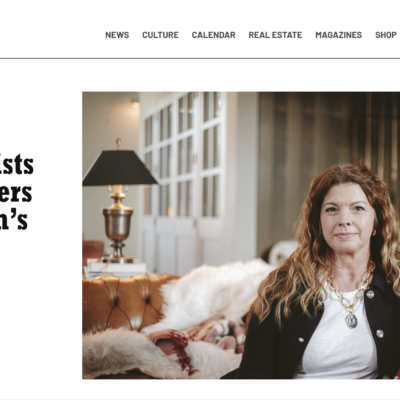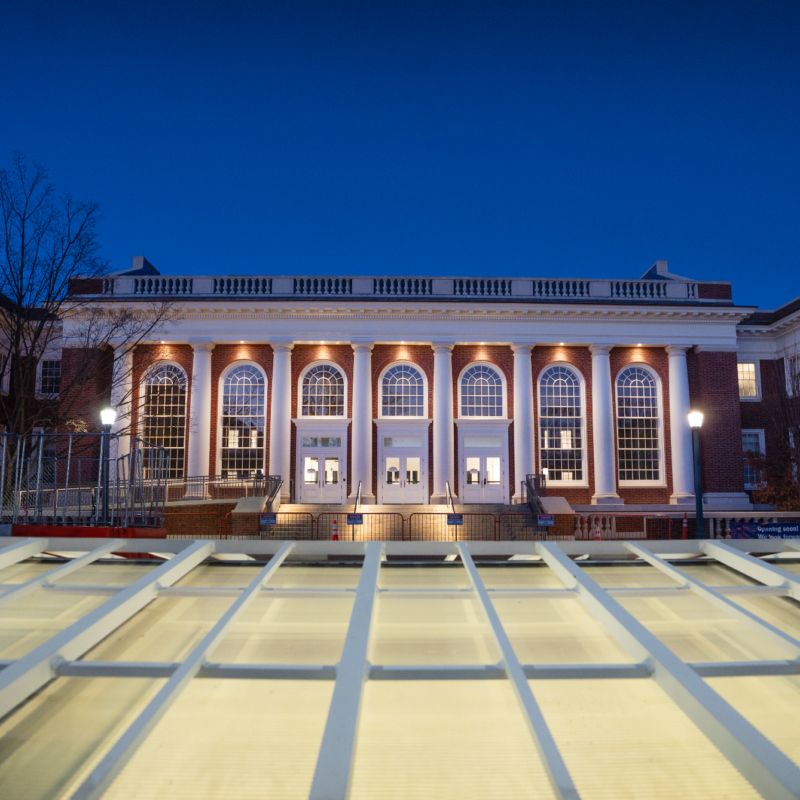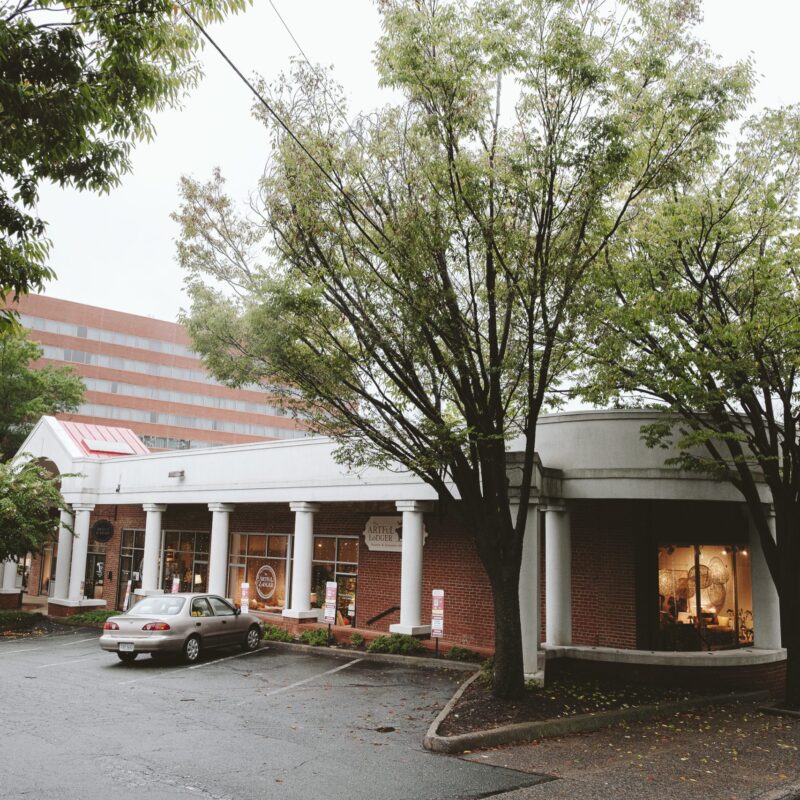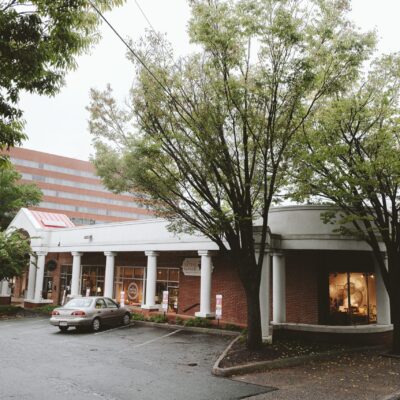Living where we do—that is, on seven acres of rocky, sloping ground that was logged a couple of decades ago—it’s clear to me that we are not even close to being in charge. There are large parts of my property I’ve never set foot on because the plant life is too thick. It’s literally all we can do to beat back the wineberry, privet, and paradise trees from the acre or so that surrounds our house, keeping those rapacious growers from swallowing the yard and garden, season by season.
|
NICE DAY FOR A WALK
Members of the local Sierra Club gather at Dripping Rock on the Blue Ridge Parkway, February 18, for a six-mile hike along the Appalachian Trail. (Photo by Brianna Larocco) |
One summer, a massive wall of blackberries fruited in the “the back field” (so called because it’s relatively clear of trees, though it still grows 10 feet high with stickweed). I happily filled containers with berries and made a few pints of jam. The next year, some other viney creature had claimed the spot, suffocating the berry bushes.
In winter, it’s easier to walk through our strange, homely woods, where opportunistic trees are clutching space among big stumps—reminders of more stately predecessors. We were out there this month, and I was shocked to see how much a group of poplar saplings had grown since the last time I bothered to notice them. Nothing stays the same in this scruffy place; everything keeps changing, and if you turn your back too long, you feel the rush of time the next time you look.
Opossums raid our chicken coop; ladybugs storm the attic. Cobwebs breed in the dining room. A huge wild turkey ran through the yard last weekend.
It’s all so alive that it takes your breath away.—Erika Howsare
|
NEWS BRIEFS Bigger tables: Local food’s big with families, but what about schools and hospitals? The Piedmont Environmental Council holds a free two-part workshop, February 24 and March 26, aimed at bringing more institutions on board with the locavore trend. More info at pecva.org/Events. Forever forested: Benjamin, Terry, and Thomas Warthen took 223 acres of their land on Piney Mountain—southwest of Charlottesville, within view of Monticello—off the table for future development. In January, the family granted the Virginia Department of Forestry a working forest conservation easement—Albemarle County’s second such easement in the Go outside and ping: Why bring your smartphone hiking? To use the new Virginia State Parks Pocket Ranger app, which lets you personalize routes, mark favorite fishing spots, share wildlife spottings with other users, and lots more. Download it for free at stateparkapps.com/apps/va/apps.php. |
Transition living
To hear the Transition movement tell it, sustainability’s no longer as simple as recycling soda cans and changing out light bulbs. Instead, we need to tackle issues surrounding peak oil, climate changes, and economic inequalities.
No simple solutions to such far-reaching environmental and economic crises. But the Transition movement—which began in the U.K. and has spread to over 100 U.S. cities and towns—aims to address these thorny problems on an everyday, local level, building community resilience.
On February 11 and 12, Charlottesville took a big step toward joining the list of official Transition Towns with a weekend workshop at CitySpace. Holly Edwards, former vice mayor, kicked off the weekend by declaring that the Transition movement “can create a society that is more abundant, more socially equitable, more environmentally friendly, and more spiritually connected.” Three Transition trainers then introduced the model to 36 attendees and raised questions about how to gain momentum and engage the public.
That includes underrepresented groups. “It’s all about finding ways to approach them passionately and as peers,” said Andrew Moore, newly active Transition member. Moore said the group wants to reach not just the upper middle class white families who already buy organic vegetables and ride their bikes to work, but also families of color below the poverty line who can barely buy groceries. Michelle Ba’th Bates, Executive Director of Female Perspective and a Transition member, noted that underserved populations are often more concerned with day-to-day survival than energy efficiency.
“It’s about listening before it’s about helping or teaching,” said Sarah Frazer, a Transition Charlottesville member. If jobs are the issue, it’s about helping to create “resilient, locally-owned jobs.” If access to healthy food is the issue, it’s about working with the farmers’ market to accept food stamps, or establishing community gardens. If energy efficiency is the issue, it’s about working with renters (because most energy efficiency programs focus on homeowners) to help lower energy bills.
Freeman admitted that many people—and groups—will hesitate to get involved because they already have too much on their plates. A multitude of Charlottesville groups are already making sustainability efforts, and Freeman said that one of the greatest challenges thus far has been collaborating and combining with these groups.
Transition Charlottesville doesn’t want “to be just another group,” said Frazer, “but to give leverage to the strengths and aspects of groups already here.”—Laura Ingles
Plastic hangers (and other stuff you don’t need)
You’ve probably already noticed: Most of what we buy is made to be thrown away. This includes everything from food packaging to electronics to clothes hangers.
Our usual plastic hangers are not recyclable. Plastic hangers are made with a mix of plastics, which makes them nearly impossible to recycle in current facilities. What to do when they break? In the old days, I would toss them in the recycle bin, cross my fingers, and hope for the best. But the truth is that they end up in a landfill anyway. Metal hangers aren’t much more eco-friendly. The plastic coating that is applied to keep them from rusting also makes them difficult to recycle.
In 2009, I made a decision to stop throwing things away. When I looked around my house, I saw a sea of disposables. I had to find alternatives for all of those old products that I used to take for granted, like toothbrushes, sponges, and pens—just to name a few. Once I got into the habit, I could spot potential garbage before it made its way into my shopping cart or drifted into my home. As any conscientious consumer knows, to reduce waste is to go against the grain of our consumer culture. Everywhere you turn, there is some piece of packaging sneaking into your life.
But there is good news. A quick Internet search reveals creative ideas to replace almost any disposable product. Companies and individual craftspeople are responding to demand, and they’re offering alternatives to all of those items that we’re so used to throwing away. If we use our purchasing power to support the alternatives, we’ll make an impact on the supply of eco-products—and we’ll save money and lots of resources in the long run.
Try it for yourself. It’s fun. You could pick one household item per month and start phasing in non-disposables. Spend 10 minutes researching your options, and pick the alternative that sounds like the best fit. Experiment. See what works for you and then spread the word to the rest of us. How about a homemade sponge? Or a wooden toothbrush? Try switching from pens to pencils. And the next time you clean out your closet, give it a makeover with some recycled cardboard hangers. At the end of their lifespan, they can be composted, recycled, or used in your fireplace.
For information about these alternative products and more, visit http://zerogarbage challenge.info/.—Rose Brown
Rose Brown heads up local nonprofit Stream Watch and occasionally gives talks about her Zero Garbage Challenge project.
/1.jpg)





